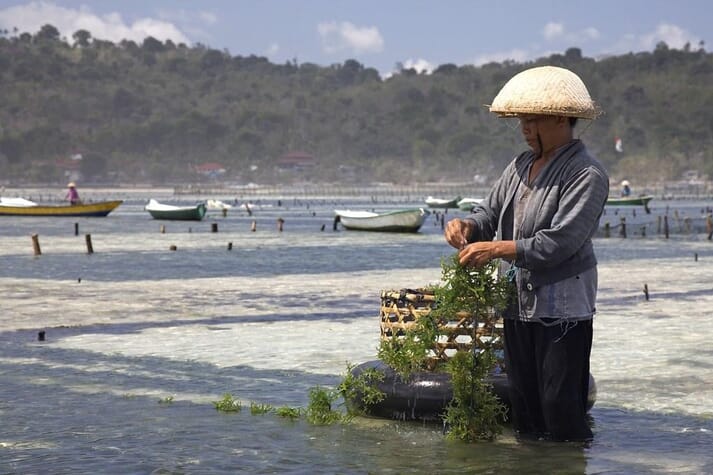“Great reboot” or short-term saviour? Bali’s seaweed farming revival
A renaissance in Bali’s seaweed farming sector is being widely touted as a sustainable alternative to tourism, following the outbreak of the Covid pandemic, but the reality is much more complicated.

© JM Hullot
The economic landscape in Bali, Indonesia, has changed dramatically since March last year when Covid-19 and associated lockdowns disrupted tourist arrivals. In 2018, 80 percent of Bali’s economy was based on tourism, as arrivals had been steadily increasing each year since 2011. While 2019 saw 6.28 million tourists visiting the island, the pandemic resulted in only 1.05 million arrivals in 2020, leaving many previously employed in the tourism sector out of work.
In recent weeks, international news outlets have presented the return of some Balinese to seaweed farming as a potential turning point for the island’s workforce – an opportunity to dilute an overreliance on foreign tourism and, in the process, alleviate some of the negative environmental externalities that tourism development has contributed. Media outlets have touted the “rediscovery” of seaweed farming, with one describing it as “The Great Reboot”, and the Australian ABC Network’s Foreign Correspondent dedicating an episode to the economic pivot, claiming “an old way of life has returned”.
But while people in Indonesia have collected seaweeds and ocean flora for centuries, seaweed farming, as it is practiced today, was only introduced to Bali in the early 1980s, and has been heavily concentrated in the island’s southern waters. Experts say that, while it’s inaccurate to present seaweed farming as a traditional way of life to be preserved, since it was introduced the practice has brought about positive economic outcomes. Despite these benefits, seaweed cultivation’s sustainability and suitability as a viable long-term livelihood alternative for many Balinese is impacted by access limitations, supply chain obstacles, and evolving socio-environmental dynamics.
Bali’s tourism trajectory
That an overreliance on tourism has characterised Bali’s economy for some decades is neither a contested fact, nor an accident. Indonesia’s 2011 Masterplan for Acceleration and Expansion of Indonesian Economic Development set out a detailed trajectory for the country’s development aspirations by the year 2025: the Bali-Nusa Tenggara Economic Corridor, which Bali falls within, was to focus developmentally on tourism and food production to promote economic growth.
While the economic success of tourism in Bali is paradoxically dependent on the environmental integrity of the island, the acceleration of what has been described as the “dizzying pace of tourism development, land alienation, and ecological degradation” has disproportionately placed the negative environmental externalities of a largely foreign-owned tourism industry on the Balinese people. A 2015 study found that, while those employed in tourism made up 25 percent of the workforce, 85 percent of the industry is non-Balinese owned. The industry accounts for 65 percent of Bali’s water consumption, and environmental costs have been particularly pronounced for the surrounding oceans, rivers and waterways, which have been affected by large amounts of plastic waste, development runoff and marine traffic.

© Joel de Vriend, Unsplash
The ebbs and flows of seaweed farming in Bali
Since its introduction in the early 1980s, most seaweed farming in Bali has occurred in the Nusa Dua region and across the Badung strait – the 12 km long narrow sea strip that separates the mainland from the southern islands of Nusa Penida, Nusa Lembongan and Nusa Ceningan, which fall within Bali’s Klungkung regency and where conditions are uniquely suited to farming certain seaweed species.
As marine biologist and director of PT Sea Six Indonesia Iain Neish tells The Fish Site, “[These areas] are unusual – they’re shallow reef flats enclosed with a beach on one side and a barrier reef on the other, and these are perfect places to grow seaweed. There’s great…
Read More: “Great reboot” or short-term saviour? Bali’s seaweed farming revival

